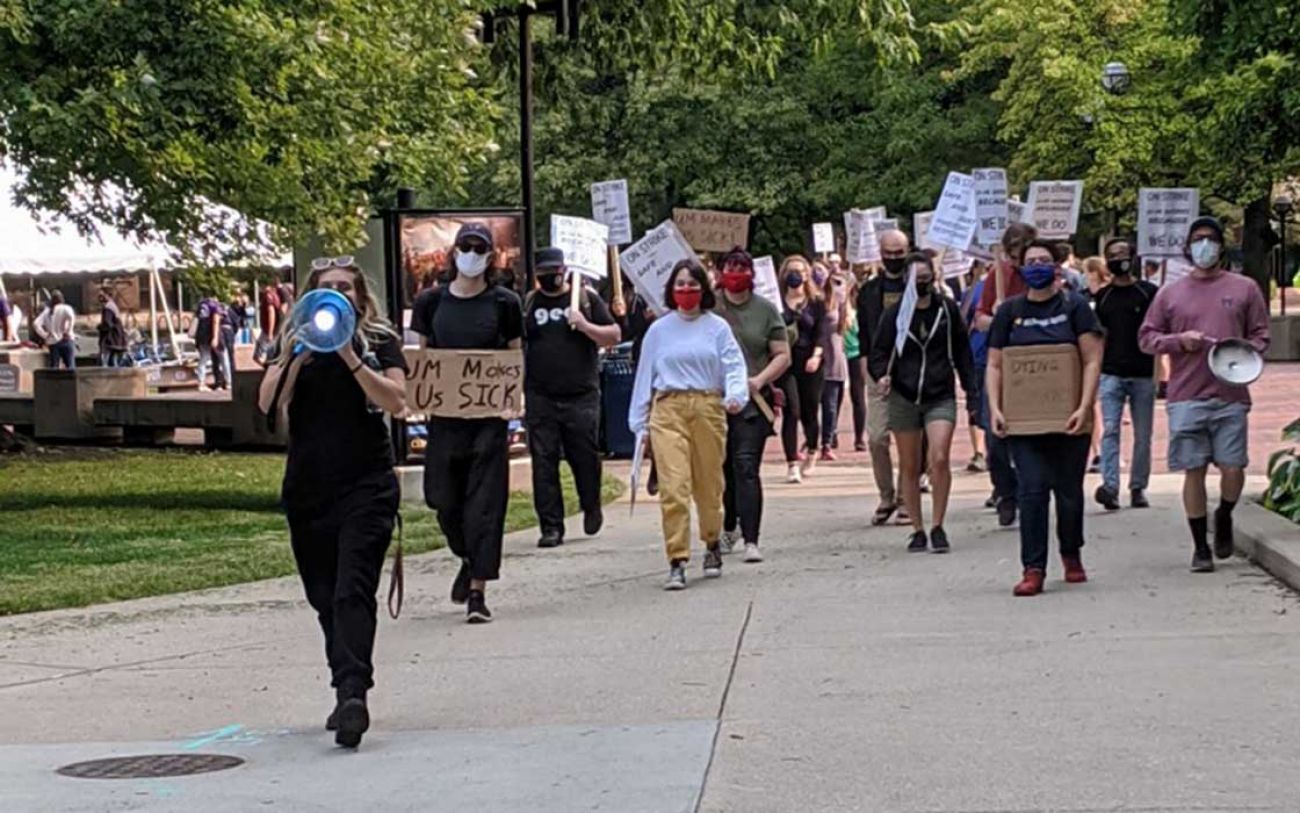How do Michigan universities compare on COVID outbreaks? Hard to tell

ANN ARBOR—The University of Michigan’s COVID-19 Data webpage is sleek, interactive and fashioned in the school colors of maize and blue.
On the site, students, parents and the public can see the number of coronavirus cases reported on campus each week since March, COVID tests given per week and positivity rates for those tests. There’s a breakdown of cases by residence hall and a chart showing the number of students in isolation (for the coronavirus) and quarantine (for being in close contact with someone who was infected).
What’s not mentioned: The U-M website significantly undercounts cases.
Related stories:
- Grand Valley State students ordered to stay home to tamp down COVID-19 upswing
- State identifies Michigan K-12 schools and colleges with COVID outbreaks
- Coronavirus outbreaks force mandatory quarantine at 23 MSU frats, sororities
- The latest: Michigan coronavirus unemployment, map, curve, updated COVID-19 news
- Dashboard: Michigan coronavirus testing numbers, trends, COVID-19 data
On Friday, the Dashboard listed 115 current cases of COVID-19 among students and staff at the 48,000-student Ann Arbor campus since Aug. 21, significantly less than some other large colleges and universities in Michigan. For example, Adrian College, with an enrollment of about 1,700, recorded 221 cases since classes resumed for the fall.
But Washtenaw County Health Department data provided to Bridge Michigan put the number of cases tied to the university over this same period at 30 percent higher — at about 150.
The reason: U-M primarily records coronavirus cases tested and confirmed at campus facilities on its dashboard, leaving out most students and staff who take COVID tests elsewhere.
Michigan State University officials acknowledge a similar undercount on their COVID dashboard because, like U-M, the school tracks those who are tested on campus, which leaves out any of the about 38,000 off-campus students who choose to get tested elsewhere.
Eye-popping numbers of coronavirus cases on some campuses across the country have made national news. But just how widespread COVID-19 is at colleges and universities is not always clear because of differences in testing and reporting protocols at those schools.
The number of COVID-19 tests U-M administers each week remains low compared to similar-sized universities. U-M has yet to exceed 2,500 tests in any week; Ohio State University, with roughly 58,000 undergraduate and graduate students, administered nearly twice as many tests in a single day last week.
Another Big Ten school, the University of Illinois at Champaign, with more than 51,000 graduate and undergraduate students, requires all faculty and staff to be tested twice a week.
U-M recently announced plans to ramp up testing. Two weeks ago, it began a program officials hope will test 3,000 self-selected students and staff every week. On Thursday, the university announced plans to administer 6,000 additional weekly tests.
Those tests will be free, but also voluntary — only students who sign up for the program will get tested.
Some other Michigan public universities also test few students.
The 21,000-student Western Michigan University tests only about 110 students a day, targeting those who are symptomatic or have been in close contact with someone who has tested positive. While Western has confirmed only 115 new cases between Sept. 9 and 16, the positivity rate is a whopping 21 percent, about seven times higher than the state’s overall rate.
State officials use 3 percent positivity as a threshold for concern about community spread. A high positivity rate suggests there are many more people with COVID-19 in the community who have yet to be tested.
The Kalamazoo County Health Department told Bridge Michigan that Western’s high positivity rate is “indicative of widespread disease transmission among WMU students.”
Grand Valley State University has more confirmed coronavirus cases among its 22,000 students than Western Michigan (600 students have tested positive since Aug. 23), but the school tests students at double the rate of Western. At Grand Valley, the test positivity rate is 3.4 percent.
“We could have not done testing and our numbers would be lower, but we wouldn’t be as safe of a community as we are right now,” Greg Sanial, chief financial officer for GVSU, said Wednesday during a news conference announcing a stay-home order for Grand Valley students to try to tamp down COVID-19 spread.
While case counts may not be a good indicator of the extent of coronavirus outbreaks at the University of Michigan, test positivity rates do offer encouragement. The share of coronavirus cases coming back with positive results is lower in Washtenaw County (1.4 percent), than in several counties with large universities, such as Ingham County, where MSU is located (4.1 percent); Kalamazoo County, where Western Michigan is located (2.6 percent) and Isabella County, where Central Michigan is located (2.5 percent).
U-M reports 78 cases in the past 14 days, according to the school’s dashboard.
“We have not yet seen cases explode around campus areas the way they have in some other university areas,” Washtenaw County Health Department spokesperson Susan Ringler-Cerniglia told Bridge. “If I’m being pessimistic, then I’m going to say, ‘Oh, we’re just a week or two behind them.’ But if I’m being optimistic, then maybe we are, as a community, really doing a better job.”
“There’s a difference between being notified of every test and being notified of the results,” Ringler-Cerniglia said. “We at the local health department find out the positive test results but we don’t necessarily have information on how many tests were administered in finding that positive.”
Signs of potentially widespread community transmission have recently begun to emerge in Ann Arbor. This past weekend, six cases were reported among staff at The Brown Jug, a popular Ann Arbor restaurant. On Thursday night, 19 students in one of the university’s dormitories were reported to have tested positive.
U-M’s dance department became the first department to cancel all in-person classes for two weeks on Tuesday after 10 percent of the department’s students were quarantined, according to a leaked email from the department chair.
Data provided by the Washtenaw County Health Department regarding cases separated by ZIP code reveal that cases in Ann Arbor have begun to climb. Ann Arbor’s five ZIP codes saw 163 confirmed COVID-19 cases from Sept. 3 to 17.
The lab-confirmed data also suggested that nearly a quarter of Washtenaw County’s 273 cases diagnosed between Sept. 3 and 17 were in people ages 18 to 24. Despite accounting for a high share of cases, young people accounted for only 2 percent of hospitalizations and no deaths in the county.
Further complicating efforts to identify cases among University of Michigan students and staff is the fact that the university has hired its own contact tracers to supplement the county’s contact tracers. In most parts of Michigan, county health departments handle that investigative work.
“We have an ongoing relationship with the University’s Environmental Health Service and Occupational Health Services,” Ringler-Cerniglia said. “When there are cases of reportable illness infections that affect the campus, students, or faculty, we work with them to follow up on those cases.”
Two students Bridge interviewed said they were contacted by both university and county contact tracers. In both instances, U-M contact tracers contacted the students almost a week after the county contacted them. (The longer it takes to identify and warn people who might be infected, the more difficult it is to curtail the virus’ spread.)
Some students say they have hesitated to provide information to contact tracers because of reportedly poor housing conditions in the school’s quarantine dorm. After a viral video surfaced of alleged unsanitary conditions in the University of Michigan’s quarantine housing, some students living in dorms have begun seeking private coronavirus tests, believing they can avoid quarantine or serve it where they live.
One student told Bridge that she told contact tracers she and her roommate could quarantine at home to avoid being placed in U-M’s quarantine housing. (This student declined to be identified for fear of professional or academic repercussions.)
“I’m sleeping in the living room. I’m doing all of the cooking and all of the cleaning. I’m dropping food off at [my roommate’s] door,” the student said. “I just wouldn’t want her to go to quarantine housing. That seems horrific.”
Ringler-Cerniglia, though, reiterated the importance of speaking candidly to contact tracers.
“What a contact tracer is doing is trying to make sure that people have and know what the public health recommendations are,” Ringler-Cerniglia said. “There’s no interest ... in penalizing people or finding out if they did something against the rules. Our interest is really in stopping the spread of that illness.”
Michigan Education Watch
Michigan Education Watch is made possible by generous financial support from:
Subscribe to Michigan Education Watch
See what new members are saying about why they donated to Bridge Michigan:
- “In order for this information to be accurate and unbiased it must be underwritten by its readers, not by special interests.” - Larry S.
- “Not many other media sources report on the topics Bridge does.” - Susan B.
- “Your journalism is outstanding and rare these days.” - Mark S.
If you want to ensure the future of nonpartisan, nonprofit Michigan journalism, please become a member today. You, too, will be asked why you donated and maybe we'll feature your quote next time!






